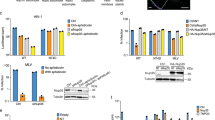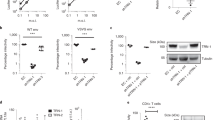Abstract
Adenovirus type 2 (Ad2) imports its DNA genome through the nuclear pore complex (NPC) of cells in interphase for viral production. Here we identify the NPC-filament protein CAN/Nup214 as a docking site for incoming Ad2 capsids. Binding to CAN is independent of cytosolic factors. Capsids disassemble at NPCs to free their DNA for import. This process requires binding of nuclear histone H1 to the stably docked capsids and involves H1-import factors, restricting this irreversible process to the proximity of the nucleus. Our results provide a molecular mechanism for disassembly of Ad2 and reveal an unexpected function of histone H1 in virus-mediated DNA import.
This is a preview of subscription content, access via your institution
Access options
Subscribe to this journal
Receive 12 print issues and online access
$209.00 per year
only $17.42 per issue
Buy this article
- Purchase on Springer Link
- Instant access to full article PDF
Prices may be subject to local taxes which are calculated during checkout









Similar content being viewed by others
References
Whittaker, G. R., Kann, M. & Helenius, A. Viral entry into the nucleus. Annu. Rev. Cell Dev. Biol. 16, 627–651 (2000).
Shenk, T. in Fundamental Virology (eds Fields, B. N., Knipe, D. M. & Howley, P. M.) 979–1016 (Lippincott-Raven, New York, 1996).
Greber, U. F. et al. The role of the nuclear pore complex in adenovirus DNA entry. EMBO J. 16, 5998–6007 (1997).
Nakano, M. Y., Boucke, K., Suomalainen, M., Stidwill, R. P. & Greber, U. F. The first step of adenovirus type 2 disassembly occurs at the cell surface, independently of endocytosis and escape to the cytosol. J. Virol. 74, 7085–7095 (2000).
Greber, U. F., Willetts, M., Webster, P. & Helenius, A. Stepwise dismantling of adenovirus 2 during entry into cells. Cell 75, 477–486 (1993).
Stoffler, D., Fahrenkrog, B. & Aebi, U. The nuclear pore complex: from molecular architecture to functional dynamics. Curr. Opin. Cell Biol. 11, 391–401 (1999).
Rout, M. P. et al. The yeast nuclear pore complex: composition, architecture, and transport mechanism. J. Cell Biol. 148, 635–651 (2000).
Ryan, K. J. & Wente, S. R. The nuclear pore complex: a protein machine bridging the nucleus and cytoplasm. Curr. Opin. Cell Biol. 12, 361–371 (2000).
Gorlich, D. & Kutay, U. Transport between the cell nucleus and the cytoplasm. Annu. Rev. Cell Dev. Biol. 15, 607–660 (1999).
Rexach, M. & Blobel, G. Protein import into nuclei: association and dissociation reactions involving transport substrate, transport factors, and nucleoporins. Cell 83, 683–692 (1995).
Snow, C. M., Senior, A. & Gerace, L. Monoclonal antibodies identify a group of nuclear pore complex glycoproteins. J. Cell Biol. 104, 1143–1156 (1987).
Wisnivesky, J. P., Leopold, P. L. & Crystal, R. G. Specific binding of the adenovirus capsid to the nuclear envelope. Hum. Gene Ther. 10, 2187–2195 (1999).
Panté, N., Bastos, R., McMorrow, I., Burke, B. & Aebi, U. Interactions and three-dimensional localization of a group of nuclear pore complex proteins. J. Cell Biol. 126, 603–617 (1994).
Fornerod, M., Boer, J., van Baal, S., Morreau, H. & Grosveld, G. Interaction of cellular proteins with the leukemia specific fusion proteins DEK-CAN and SET-CAN and their normal counterpart, the nucleoporin CAN. Oncogene 13, 1801–1808 (1996).
Chi, N. C., Adam, E. J. H. & Adam, S. A. Sequence and characterization of cytoplasmic nuclear protein import factor p97. J. Cell Biol. 130, 265–274 (1995).
Yokoyama, N. et al. A giant nucleopore protein that binds Ran/TC4. Nature 376, 184–188 (1995).
Greber, U. F. & Gerace, L. Nuclear protein import is inhibited by an antibody to a lumenal epitope of a nuclear pore complex glycoprotein. J. Cell Biol. 116, 15–30 (1992).
Nakielny, S., Shaikh, S., Burke, B. & Dreyfuss, G. Nup153 is an M9-containing mobile nucleoporin with a novel ran-binding domain. EMBO J. 18, 1982–1995 (1999).
Nakano, M. Y. & Greber, U. F. Quantitative microscopy of fluorescent adenovirus entry. J. Struct. Biol. 129, 57–68 (2000).
Greber, U. F., Webster, P., Weber, J. & Helenius, A. The role of the adenovirus protease in virus entry into cells. EMBO J. 15, 1766–1777 (1996).
Cerf, C. et al. Homo- and heteronuclear two-dimensional NMR studies of the globular domain of histone H1: full assignment, tertiary structure, and comparison with the globular domain of histone H5. Biochemistry 33, 11079–11086 (1994).
Thomas, J. O. Histone H1: location and role. Curr. Opin. Cell Biol. 11, 312–317 (1999).
Rux, J. J. & Burnett, R. M. Type-specific epitope locations revealed by X-ray crystallographic study of adenovirus type 5 hexon. Mol. Ther. 1, 18–30 (2000).
Bustin, M. Preparation and application of immunological probes for nucleosomes. Methods Enzymol. 170, 214–51 (1989).
Jakel, S. et al. The importin beta/importin 7 heterodimer is a functional nuclear import receptor for histone H1. EMBO J. 18, 2411–2423 (1999).
Sodeik, B. Mechanisms of viral transport in the cytoplasm. Trends Microbiol. 8, 465–472 (2000).
Suomalainen, M., Nakano, M. Y., Boucke, K., Keller, S. & Greber, U. F. Adenovirus-activated PKA and p38/MAPK pathways boost microtubule-mediated nuclear targeting of virus. EMBO J. 20, 1310–1319 (2001).
Ojala, P. M., Sodeik, B., Ebersold, M. W., Kutay, U. & Helenius, A. Herpes simplex virus type 1 entry into host cells: reconstitution of capsid binding and uncoating at the nuclear pore complex in vitro. Mol. Cell. Biol. 20, 4922–4931 (2000).
Russell, W. C. Update on adenovirus and its vectors. J. Gen. Virol. 81, 2573–2604 (2000).
Fornerod, M. et al. The human homologue of yeast CRM1 is in a dynamic subcomplex with CAN/Nup214 and a novel nuclear pore component Nup88. EMBO J. 16, 807–816 (1997).
Huber, J. et al. Snurportin1, an m3G-cap-specific nuclear import receptor with a novel domain structure. EMBO J. 17, 4114–4126 (1998).
Doenecke, D. et al. Histones: genetic diversity and tissue-specific gene expression. Histochem. Cell Biol. 107, 1–10 (1997).
Parseghian, M. H., Henschen, A. H., Krieglstein, K. G. & Hamkalo, B. A. A proposal for a coherent mammalian histone H1 nomenclature correlated with amino acid sequences. Protein Sci. 3, 575–587 (1994).
Leclerc, D., Chapdelaine, Y. & Hohn, T. Nuclear targeting of the cauliflower mosaic virus coat protein. J. Virol. 73, 553–560 (1999).
Kann, M., Sodeik, B., Vlachou, A., Gerlich, W. H. & Helenius, A. Phosphorylation-dependent binding of hepatitis B virus core particles to the nuclear pore complex. J. Cell Biol. 145, 45–55 (1999).
Mabit, H., Breiner, K. M., Knaust, A., Zachmann-Brand, B. & Schaller, H. Signals for bidirectional nucleocytoplasmic transport in the duck hepatitis B virus capsid protein. J. Virol. 75, 1968–1977 (2001).
Lever, M. A., Th'ng, J. P., Sun, X. & Hendzel, M. J. Rapid exchange of histone H1.1 on chromatin in living human cells. Nature 408, 873–876 (2000).
Misteli, T., Gunjan, A., Hock, R., Bustin, M. & Brown, D. T. Dynamic binding of histone H1 to chromatin in living cells. Nature 408, 877–881 (2000).
Saphire, A. C. S. Guan, T. L., Schirmer, E. C., Nemerow, G. R. & Gerace, L. Nuclear import of adenovirus DNA in vitro involves the nuclear protein import pathway and hsc70. J. Biol. Chem. 275, 4298–4304 (2000).
Suomalainen, M. et al. Microtubule-dependent minus and plus end-directed motilities are competing processes for nuclear targeting of adenovirus. J. Cell Biol. 144, 657–672 (1999).
Pinol-Roma, S. & Dreyfuss, G. Shuttling of pre-mRNA binding proteins between nucleus and cytoplasm. Nature 355, 730–732 (1992).
Yokoyama, N. et al. A giant nucleopore protein that binds Ran/TC4. Nature 376, 184–188 (1995).
Bustin, M. & Stollar, B. D. Immunochemical specificity in lysine-rich histone subfractions. J. Biol. Chem. 247, 5716–21 (1972).
Melchior, F., Paschal, B., Evans, J. & Gerace, L. Inhibition of nuclear protein import by nonhydrolyzable analogues of GTP and identification of the small GTPase Ran/TC4 as an essential transport factor. J. Cell Biol. 123, 1649–1659 (1993).
Drabent, B., Kunz, C. & Doenecke, D. A rat histone H2B pseudogene is closely associated with the histone H1d gene. Biochim. Biophys. Acta 1172, 193–196 (1993).
Acknowledgements
We thank P. Groscurth for access to the confocal laser scanning microscope and P. Sonderegger for access to the SMART system, U. Ziegler and P. Cinelli for assistance and U. Aebi, U. Kutay and T. Misteli for comments on the manuscript. Numerous investigators are gratefully acknowledged for their gifts of reagents (and are indicated in the Methods section) and H. van der Velde is acknowledged for preparation of C terminus CAN/Nup214. The work was supported by the Swiss National Science Foundation and the Kanton of Zürich.
Author information
Authors and Affiliations
Supplementary information
Supplementary Figures
Figure S1 Microinjected anti-NPC antibodies reduce nuclear import of FITC–BSA–NLS. (PDF 614 kb)
Figure S2 Histone H1 import factors are required for nuclear import of Ad2–DNA.
Rights and permissions
About this article
Cite this article
Trotman, L., Mosberger, N., Fornerod, M. et al. Import of adenovirus DNA involves the nuclear pore complex receptor CAN/Nup214 and histone H1. Nat Cell Biol 3, 1092–1100 (2001). https://doi.org/10.1038/ncb1201-1092
Received:
Revised:
Accepted:
Published:
Issue Date:
DOI: https://doi.org/10.1038/ncb1201-1092
This article is cited by
-
The serine-48 residue of nucleolar phosphoprotein nucleophosmin-1 plays critical role in subcellular localization and interaction with porcine circovirus type 3 capsid protein
Veterinary Research (2021)
-
MxB is an interferon-induced restriction factor of human herpesviruses
Nature Communications (2018)
-
Proteomic analysis of A-549 cells infected with human adenovirus 40 by LC-MS
Virus Genes (2018)
-
Nuclear domain 10-associated proteins recognize and segregate intranuclear DNA/protein complexes to negate gene expression
Virology Journal (2012)
-
Revisiting HIV-1 uncoating
Retrovirology (2010)



